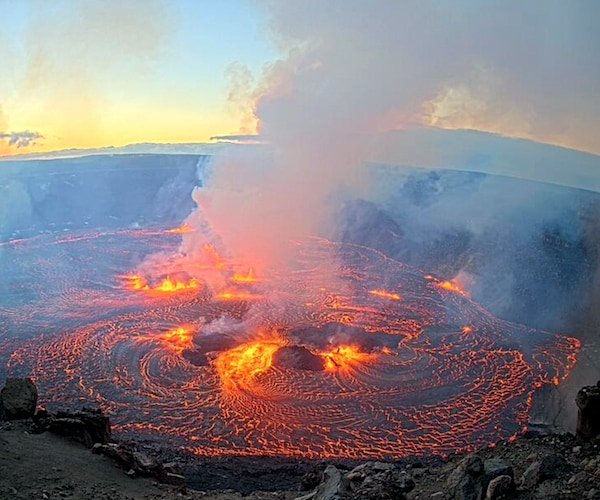Hawaii’s Kilauea Erupts, Spews Lava 200 Feet Into Air
The Kilauea volcano on Hawaii’s big island erupted Wednesday after a three-month pause, spewing lava at the summit of the Halema’uma’u crater as high as 200 feet.
But officials said the lava flow is not expected to be a threat to the public.
“This does not seem to be developing the way the 2018 eruption had,” Adam Weintraub, communication director for the Hawaii Emergency Management Agency, told Hawaii News Now, referring to the 2018 Kilauea eruption in the lower Puna district, where lava flow destroyed hundreds of homes. “They’re keeping a close eye outside the caldera toward the rift zones, but at this point, it looked like the lava was contained within the summit and within the crater itself.”
At about 4:45 a.m. Wednesday local time, webcam images showed a glow at the summit, indicating an eruption had started. Moments later, images showed fissures at the base of the crater, generating lava flows on the surface of the crater flow.
The U.S. Geological Survey’s Hawaiian Volcano Observatory said in an advisory that by 8 a.m., 33 feet of new lava had been added to the crater floor and fountains at the summit were “consistently” in excess of 50 feet.
The observatory said the alert level for the volcano is “warning/red.”
“The eruption is occurring within a closed area of Hawai’i Volcanoes National Park,” the observatory said. “Therefore, high levels of volcanic gas are the primary hazard of concern, as this hazard can have far-reaching effects downwind.
“Large amounts of volcanic gas — primarily water vapor, carbon dioxide, and sulfur dioxide — are continuously released during eruptions of the Kīlauea volcano. As [sulfur dioxide] is released from the summit, it will react in the atmosphere to create the visible haze known as vog [volcanic smog] that has been observed downwind of Kīlauea. Vog creates the potential for airborne health hazards to residents and visitors, damages agricultural crops and other plants, and affects livestock.”
Scientists said the volcano’s elevated activity started Tuesday night, with more tremors, ground deformation at the summit, and the movement of magma in the subsurface.
“Every eruption’s a little different,” David Phillips, deputy scientist-in-charge for the Hawaii Volcano Observatory, told Hawaii News Now. “For the one that happened [Wednesday] morning, we had 65 minutes of precursory activity that we were pretty confident would lead to an eruption in this case.”
© 2023 Newsmax. All rights reserved.




